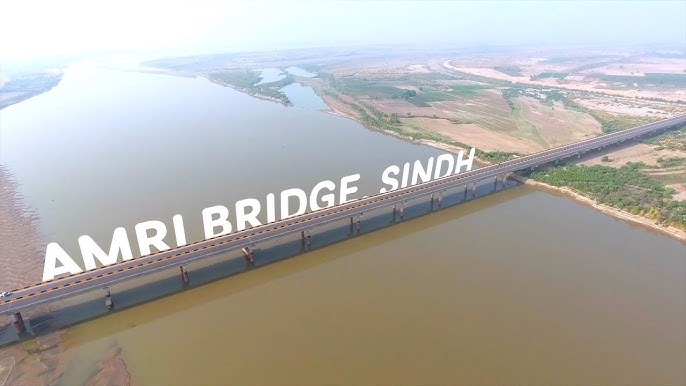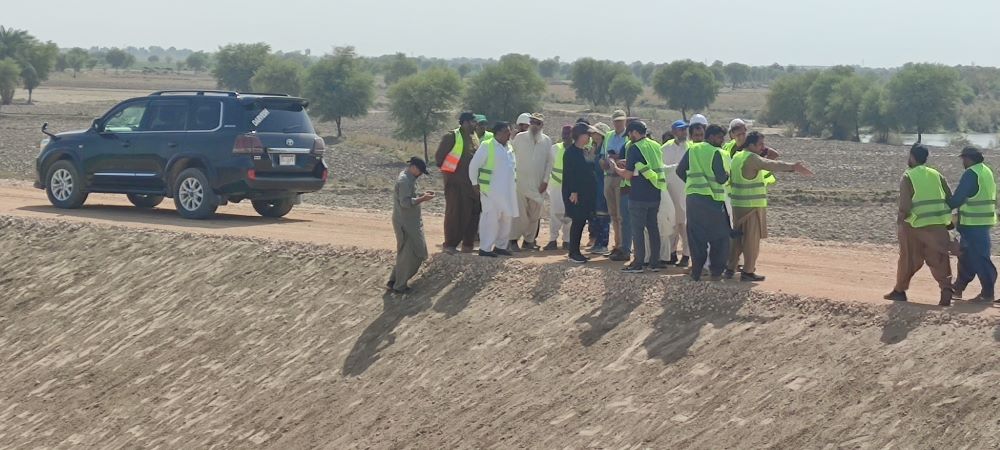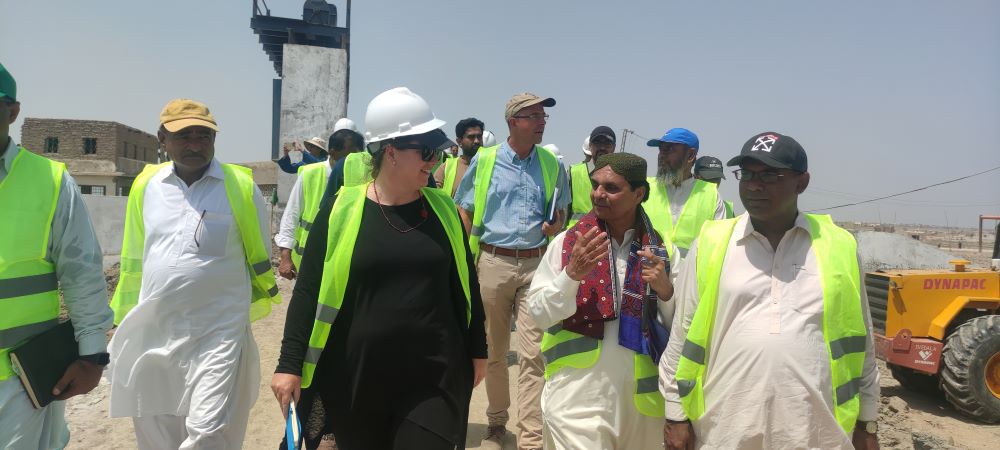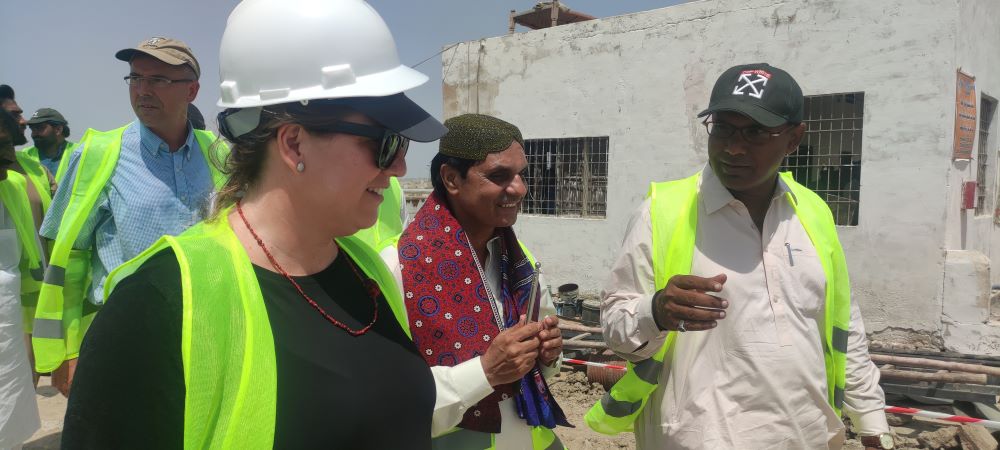
WB Technical Mission inspects rehabilitation work of Manchhar Lake and its canals; rehabilitation work is expected to be completed by end of current month
By Rehan Khan Khushik
Sehwan, Sindh
The Amri-Qazi Ahmed Bridge built over Indus River connecting Indus Highway to the National Highway, caused blockade of flood water in 2022.
The Indus River bed at this place is about 13km wide, while the length of bridge is 1.5km, which hindered the flood water causing severe damages.
“During 2010 high flood in River Indus, the river had 13km wide bed but after the construction of Amri Bridge, the river bed became narrow to 1.5 km which caused rise in water level during 2022 developing pressure on embankments on both left and right sides. It also created difficulties to discharge water from Manchhar Lake to River Indus,” Iqbal Ahmed Palijo, Additional Director Sindh Flood Emergency Rehabilitation Project told during a visit of World Bank Technical Mission on September 1, 2023.
“This bridge caused the water level raised in River Indus by two feet during high flood 2022,” he said.
 The World Bank technical mission comprised of Ms. Amparo Samper Hiraldo, Senior Disaster Risk Management Specialist, Mr. Juan Soler Cabado, Mr. Hendrik Arnold Vernoon, Bilal Khalid, Ms. Hina Lotia, and Aijaz Shaikh visited the Aral head regulator, Aral Tail and Danister Canal of Manchhar Lake, which covers the areas of Sehwan taluka in Jamshoro district and Johi taluka in Dadu district.
The World Bank technical mission comprised of Ms. Amparo Samper Hiraldo, Senior Disaster Risk Management Specialist, Mr. Juan Soler Cabado, Mr. Hendrik Arnold Vernoon, Bilal Khalid, Ms. Hina Lotia, and Aijaz Shaikh visited the Aral head regulator, Aral Tail and Danister Canal of Manchhar Lake, which covers the areas of Sehwan taluka in Jamshoro district and Johi taluka in Dadu district.
According to environmental experts this is dying lake as the lake has turned brackish due to release of toxic water through Main Nara Valley Drain.
The WB mission also observed the ongoing flood rehabilitation work at embankments of Manchhar Lake, relief cuts site at RD (Reduced Distance) 14 and 52 of Manchhar Lake. The relief cuts were given during 2022 flood.
World Bank technical mission inspected the Karampur Ring Bund constructed to protect 50000 population of historical city Karampur from floods.
Iqbal Ahmed Palijo briefed the WB team about rehabilitation work at Manchhar Lake and its components including the rehabilitation structure of Aral head regulator of Manchhar Lake.
He said that all flood rehabilitation works at Manchhar Lake will be completed by 30 September 2023.
 Deputy Director SFERP Balram in his briefing said that 95 percent rehabilitation work of Danister tail regulator and Aral head regulators has been completed. He said that discharge capacity of Danister Canal was increased from 500 cusecs to 5000 cusecs.
Deputy Director SFERP Balram in his briefing said that 95 percent rehabilitation work of Danister tail regulator and Aral head regulators has been completed. He said that discharge capacity of Danister Canal was increased from 500 cusecs to 5000 cusecs.
The WB mission hoped the timely completion of rehabilitation of Manchhar Lake to ensure the protection from future floods.
“Discharge capacity was enhanced from 37000 cusecs to 82000 cusecs from Manchhar Lake to River Indus through three sources including Aral head regulator, Aral Tail and Danister Canal,” Ms. Amparo Samper Hiraldo, Senior Disaster Risk Management Specialist told.
“Karampur bund has also been rehabilitated near Sehwan as it was also used for travelling purpose by the local settlements and in 2022 flood when it was high flood in River, relief cuts were made at Manchhar Lake to reduce the losses of flood disaster,” said Ms. Amparo Samper Hiraldo.
“During 2022 high flood, Sehwan city was also under serious threat of flooding hence to protect Sehwan city, the 19 RDs of Aral left embankment have been rehabilitated,” Mr. Hendrik Arnold Vernoon WB mission member told this correspondent.
“With rehabilitation of Aral left embankment, Sehwan city and its surroundings settlements will remain safe in flood disasters in future from Hill torrents, Manchhar Lake water, and River Indus water as well,” Hendrik Arnold Vernoon said.
“Manchhar Lake has 1 million acre feet capacity to restore water while 0.16 million acre feet water can be discharged within 24 hours from Manchhar Lake and if there will be emergency situation, Manchhar Lake can be emptied between five to seven days through its upgraded Aral head regulator, Aral Tail and Danister Canal,” Mr. Juan Soler Cabado WB mission member told.
 “Total 30km of Manchhar lake embankments were raised from 127 feet height to 129 feet height and its width was increased from 20 feet to 30 feet to protect the local settlements from inundating,” Iqbal Ahmed Palijo briefed the WB mission during visit to Aral head regulator structure of Manchhar lake.
“Total 30km of Manchhar lake embankments were raised from 127 feet height to 129 feet height and its width was increased from 20 feet to 30 feet to protect the local settlements from inundating,” Iqbal Ahmed Palijo briefed the WB mission during visit to Aral head regulator structure of Manchhar lake.
“182km long embankments of flood protective bund stands in Sindh province and 169km in Balochistan province and resists the hills torrents of Khirthar Mountain Range to Sindh province,” Aijaz Shaikh irrigation expert WB said.
“With the completion of the rehabilitation work, the communities settled along the Manchhar Lake, their agriculture land, standing crops, livestock and other livelihoods, public infrastructures and available water resources in the area would be protected,” Social Safeguard Consultant Nasir Panhwar briefed.
“These benefits will ultimately manifest in protection and contribute to improvement in the lives of vulnerable people,” said Panhwar.
“Manchhar Lake was fresh water lake and it turned into brackish water due to disposal of saline water through Main Nara Valley Drain which has destroyed the boat culture and civilization of Manchhar Lake,” he said.
World Bank technical mission also met the local communities of fishermen at Manchhar near Bubak town.
Moula Bux Mallah chairman Manchhar Bachayo Ittehad hoped that with rehabilitation of Manchhar lake embankment, their settlements will remain safe from future floods.
___________________
WB Mission Visit Photos by the Correspondent
[…] Read: Ill-Planned Amri Bridge over Indus River caused floods in 2022 […]